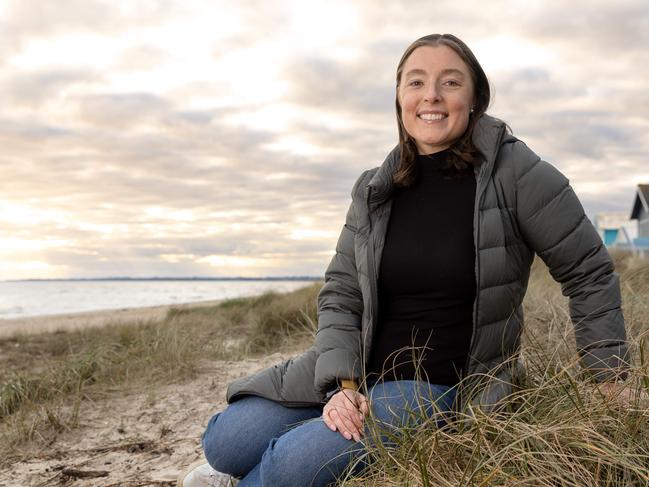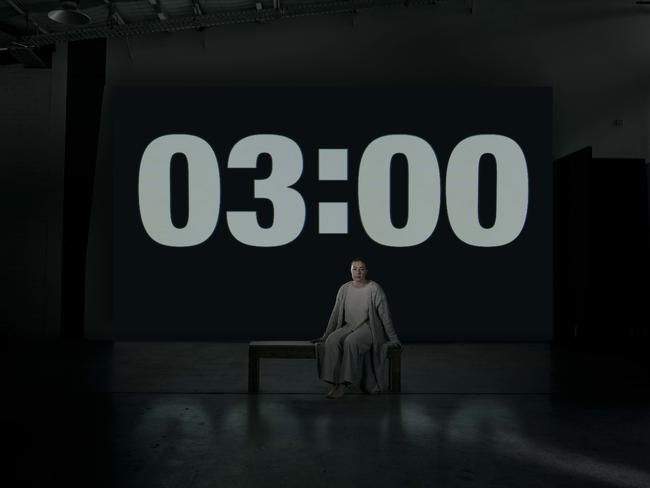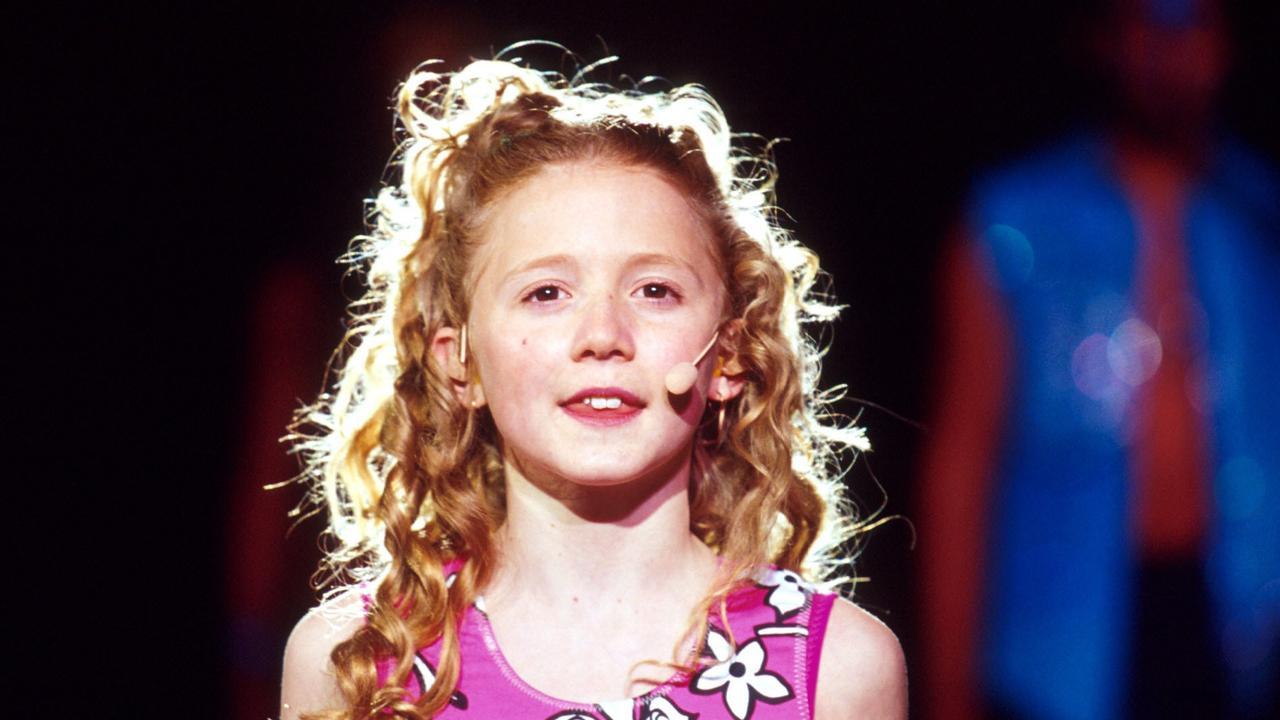Dying woman Emily Lahey auctions off her final minutes for cancer research
Emily Lahey is dying and doesn’t know how much time she has left. But she’s decided to do something that no one has ever done before.

NSW
Don't miss out on the headlines from NSW. Followed categories will be added to My News.
Emily Lahey is dying. She’s not sure how much time she has left on this earth – days, weeks, months or, hopefully, years – but she is determined to leave it better than she found it.
And she is.
The 32-year-old is about to do something never been done before. Next month, she will host a once-in-a-lifetime living art exhibition, where she will auction off three-minute pieces of her remaining time to raise money for cancer research. Research like that which has already given Lahey three years of borrowed time, after being diagnosed with an incredibly rare and aggressive cancer in 2019, when she was told she had less than nine months to live.
In the face of a terminal illness, her powerful Time to Live: A Terminal Exhibition will allow those moved by her plight to sit with her as the clock ticks down from three minutes to zero. That’s 180 seconds. To talk about death, life and everything in between. Or to sit in silence, and reflect on fears, wishes and impending mortality.
Once your time is up, that’s it. An overwhelming reality facing us all, but it is staring Lahey in the face every day. And far too soon.
“There’s been nothing like it before,” she says of the exhibition.
“One of the key goals is to make people stop and think about the their time, and the time of the people that they love, and what they’re doing with their time and how they can make the most of that time they have.
“Anything can happen to anyone at any time.
“It’s almost a privilege to be able to see life through a different lens, as opposed to rose- coloured glasses – to be able to make the most of it.
“There’s something powerful about being able to take ownership of your life and make those decisions ... a lot of people don’t have that opportunity.
“People that are facing terminal illness, we see life with a different lens.
“Both my family and I no longer take things for granted; we no longer take time together for granted.
“We just try and make the most of every day. We celebrate small wins, big wins – any excuse to celebrate something.
“Yes, it is very, very challenging – but there is an element of power in being able to maintain some level of control among a situation that you’ve got so little control over.”

The Tasmanian-born one-time Sydneysider now calls Melbourne home, and was like anyone else before October 2019. She was 27. Fit, healthy, driven. She was a member of the Australian Defence Force and had dreams of a long and accomplished career, buying her own home, having a family.
Then headaches and sinusitis symptoms were dismissed as such – until Lahey started losing vision from her left eye. Scans showed a cricket ball-sized mass in her sinus skull bone, and a diagnosis of NUT carcinoma, with a six-to-nine-month survival rate. About 100 people are diagnosed with the rare cancer every year. It’s hard to test for and diagnose, it doesn’t respond well to standardised treatments. There is no cure.
“Before I was diagnosed, I was otherwise fit and healthy. I was running 5 to 10km a day, was in the height of my career,” Lahey says. “I obviously had dreams and hopes and goals, like anybody that age would, and then within an instant, all of that was taken away,” she says.
“My treating oncologist had never heard of that type of cancer before, which I guess doesn’t instil a lot of confidence initially, although I have nothing but positive things to say about my treating medical team.
“It was just by chance that there was somebody on exchange from the UK or US working at The Alfred Hospital here in Melbourne at the time that had heard of it, and was able to reach back to some colleagues and we were able to get a little bit more info about it.
“What wasn’t communicated to me at the time was the prognosis and lack of treatment options available, which we unfortunately found out through a Google search, which made it even more awful.
“I remember my mum sitting next to me at the hospital, where I was being treated as an inpatient, about to start chemotherapy, and she said ... ‘that’s just not you’.
“She said, ‘You are the exception’.
“And I guess, in time, I’ve proven that I am the exception.”
She’s the exception because she’s still here. After brutal – and unsuccessful – rounds of chemo, radiotherapy and immunotherapy, a potential treatment option not available in Australia was identified. Lahey was granted special access to this treatment, which has brought her three additional years of life – time she was told wasn’t possible. Genomic testing was sent to Sydney’s renowned Garvan Institute, and as a result, for the past three years Lahey has taken targeted treatment of seven tablets five days a week.
She is the longest-surviving patient using this treatment.
Recently, however, it was discovered the cancer had spread to her brain. Doctors cannot tell how long she has.
But whatever time Lahey has left, she’s making it count.
“I would say I’ve had success; it’s not a drug that can cure you or make you cancer free, but as long as things remain stable, then that’s a win,” she says.
“I’ve had some regrowth of my primary tumour in that time, and also metastasis to the brain ... so I guess that falls back into my belief into cancer research, because without things like genomic testing, targeted treatments and support for people with rare cancers, I wouldn’t be here. I’m proof that it works.
“It obviously still sits very heavy on me and my loved ones ... but I think there’s a part of me that has disassociated from the disease.
“I don’t look in the mirror and see somebody that, on paper, is terminally ill.
“I’ve fought hard over the last nearly five years now to live as normal life as I can.”

Three weeks before her shock diagnosis, Lahey started going out with someone new, but when she learnt what lay ahead she urged him to move on with his life.
But Jason Gregson stayed – Lahey says you would struggle to find a more positive person – and they were married in November last year. It was one of the highlights of their lives, and a future they weren’t sure they’d be blessed with.
Buying a house, which they did, was something else on Lahey’s bucket list, which she likes to call her “living list”.
“We had the most beautiful day; it was just a dream,” she says.
“A lot of people have a bucket list; I have a living list, and we’ve made it our mission to tick off as many of those things as we can.
“Some of them have been quite extravagant, whereas others have been pretty mundane.
“I’m a member of the defence force, so current serving member of the army, and it was my goal to reach the rank of sergeant by the age of 30, which I was still able to achieve.
“I purchased my first home by the age of 30. Obviously, we got married.
“There’s been some travelling, although covid ruined a lot of those plans. I wanted to swim with the whale sharks in Exmouth, which we did. I was able to stay at Saffire Freycinet (Tasmania) for my 31st birthday. I wanted to swim in the pool at the Marina Bay Sands (Singapore), which my mother and I did last year.
“Jason and I walked the three-day trek at Capes Track in southern Tasmania. I’m not gonna say it was easy, but the sense of achievement having done that was just phenomenal.
“I think we just try and make the best of every day, and I’m just so thankful for the opportunities we’ve been given that we wouldn’t have been given if it wasn’t for these advances in medical research.”
One of the hard things for Lahey is that she doesn’t look sick. She’s still able to function, and her body is getting used to what’s happening.
“It’s really challenging and I think you control what you can control, and that’s always been a priority to me,” she says.
“Even when I started to lose my hair during chemo, the decision was made that I would shave my head, because you just clutch on to those tiny little things that you can control.
“I know my family has really struggled to deal with my prognosis, and my friends as well. “There’s been lifelong friends that I’ve had and subsequently lost because they don’t know how to deal with it.
“They don’t know how to support, it’s almost ‘too-hard basket’ for them, because it makes people so uncomfortable and they just can’t deal with it.
“Because, on face value, I don’t look sick. I don’t look like I have a terminal illness, because people associate terminal illness with end of life.
“I’m not skin and bones, I have a head of hair, I go to the gym and I go to the supermarket and you wouldn’t know if you didn’t know.
“And I think that also forms part of this campaign, that this can happen to anyone. And it can be happening to anyone.
“It can be your neighbour, the person you train with at the gym, the person you will pass in the supermarket.
“So I want to create that wider awareness as to not just the impact, but also to fight societal norms of what cancer and terminal illness looks like.
Lahey says it is not a part of her life she would normally advertise.
“Like, I don’t introduce myself and say, ‘Hi, I’m Emily and I have a terminal illness’ – it’s a mood killer,” she says.
Today, like most days, Lahey feels as well as she can feel. The vision in her left eye never returned, presenting new challenges. She gets scans every three months to monitor the cancer that metastasised on her brain. She’s never out of the woods, just in the limbo of “scanxiety” that every 60 days determine her fate.
“The biggest scare or worry for me is that if and when my condition does deteriorate, there are no other treatment options available to me,” Lahey says.
“The targeted treatment that I’m on now is sort of a last resort, and I’d begin looking at clinical trials which, as of two days ago, there are none here in Australia.
“So that’s overwhelmingly the biggest anxiety. You go into those scans expecting the worst, but hoping for the best.
“I used to make a big deal out of positive results, whereas now I just breathe out and wait for the next slot.
“I’m obviously thankful that the results are positive, but it still doesn’t mean that it’s good news.”


That makes cancer research more important than ever. And through Time to Live: A Terminal Exhibition, Lahey is raising both money and awareness for the Australian Cancer Research Foundation as her last gift to the world. A gift that will one day lead to answers.
“There’s been a paper that was written up in a medical journal on my case ... to provide that as a lifeline for somebody else, whether they’re in Australia or overseas,” Lahey says.
“I’m hoping that I can use my experiences to do something positive.”
Time to Live is that something, too. The interactive artwork invites the public to engage in one-on-one time with Lahey, highlighting the preciousness of time and the gravity of her life, as a projection counts down from three minutes.
The profound encounter offers a unique opportunity to grasp the emotional and psychological weight of living with, or being connected to someone with a terminal diagnosis.
Interested guests can apply online and pledge the amount they’re willing to donate for three minutes spent with Lahey.
“I feel privileged, I feel nervous, but I think if people just stop and think for a moment, that wider impact has the potential to have quite a wide reach,” she says.
“So people that participate will be shown my life story through a spoken narrative, and photos and video footage from my life, which form part of the installation, and through that narrative it’s designed to make people feel a level of discomfort, to a degree.
“Then I will sit with that person for three minutes, with the counter counting down.
“There’s no script. If people want to talk, we talk. If people want to sit in silence, we’ll sit in silence
“If people want a physical connection. we’ll create that physical connection.
“I don’t know if it’s healthy or not, but I’ve disassociated with the disease, to a degree.
“It’s not something I see when I look in the mirror, so you just sort of carry on.
“When I was first diagnosed, my mum and I had this little mantra between us, and that was ‘be present’.
“Be present in that moment, in that day.
“At that time, I lacked the ability to plan too far ahead – it was literally just that day. And then it was maybe to the end of the week, and then as time has gone, that ability to look further out has increased.
“Over time, as well, there’s been some opportunities that have presented themselves, through charities, non-profits, and within that patient advocacy space, and that’s how can I use my experiences to educate, empower and impact other people to create change, be that on an individual community or government level, for other patients with rare cancers.
“This is the largest and most impactful campaign that I’ve had the pleasure to be part of.”
Lahey has made a will and has a playlist of songs for her funeral – part of taking control of the uncontrollable. She’s even left specific gifts and experiences for family and friends, and is getting to do some of those with them now, instead of them having to do it after she’s gone.
“A lot of those friends don’t even know that those experiences were for that purpose,” Lahey says.
“Jason and I took some of our friends to the Jackalope Hotel on the Mornington Peninsula, as it was something they had always wanted to do ... so we took them as a surprise one weekend and the whole experience was just phenomenal.

“I have changed,”Laheysays of herself post diagnosis. “I definitely find it easier to let go of things that no longer serve me.
“I’m a lot better at not getting wrapped in the small things and small inconveniences.
“This whole experience has given me a greater perspective about just life in general.
“The way in which I treat other people, in that you don’t know what other people have got going on.
“It’s that whole road rage thing: You might see people driving like a maniac, and people go nuts on the road. That person in that car may have just found out that their daughter has six months to live.
“It’s given me a greater insight as to the human condition and how important it is that we treat people with kindness.
“I think when you’re young, you think you know what your purpose is, and for me, that was a long-term career in the defence force, and probably getting married, starting a family – just life stuff. When that stuff is taken away from you, I guess you have two choices: You can remain stagnant, or you can pivot.
“How can I regain a sense of purpose? And what does that sense of purpose look like?
“For me, that is what has been.”
Time to Live will take place on Saturday, August 17 at Sydney’s Carriageworks
Originally published as Dying woman Emily Lahey auctions off her final minutes for cancer research



